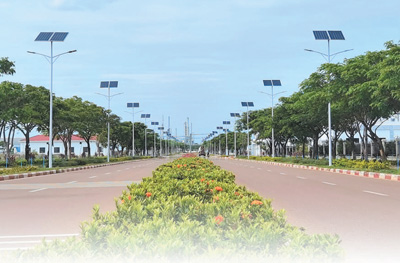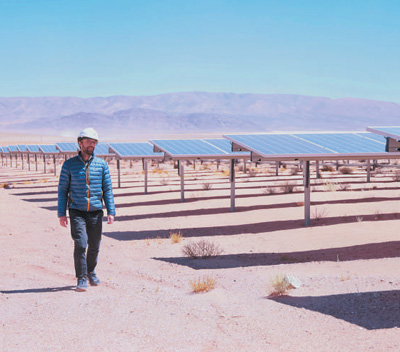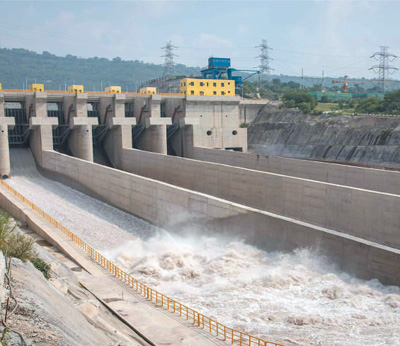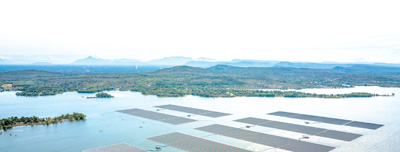Release Date:2023-10-09 Visits:67 Source:People's Daily Author:Huayang New Energy

Saisetta Comprehensive Development Zone in Vientiane, Laos, vigorously promotes the construction of green and low-carbon parks. The picture shows the solar street lights installed in the development zone. Photo by Sun Guangyong, reporter of this newspaper

At the site of the Gauchari photovoltaic power station project in Argentina, the staff is conducting daily inspections. Photo by Song Yeran, reporter of this newspaper

Kalot Hydroelectric Power Station, Pakistan. Photo by Xue Dan, reporter of this newspaper

Zanatas wind farm in Zanatas, Kazakhstan. Photo by Zhang Xiaodong, reporter of this newspaper

Construction workers inspect power generation facilities at the construction site of the Socian Geothermal Power Plant project in Nakuru, Kenya, May 26. Acceptable geothermal power projects help Kenya bridge the power gap and accelerate the energy transition. Photo by Xinhua News Agency reporter Wang Guansen

A floating photovoltaic project photographed at the Sirindhorn Reservoir in Ubon Ratchathani Province, Thailand. This is the largest floating photovoltaic project jointly built by China and Thailand and currently in Thailand. Photo by Xinhua News Agency reporter Wang Teng
This year marks the 10th anniversary of the Belt and Road Initiative. In the past 10 years, from the conception of the layout to the meticulous design, China and the countries and regions jointly built have painted the beautiful picture of the "Belt and Road" with green brushes and worked together to build a beautiful earth home.
Clean energy cooperation helps build a green Silk Road. In recent years, a series of clean energy cooperation projects have been successfully carried out, and a number of photovoltaic power stations, wind power stations and hydropower stations have been put into operation in the "Belt and Road" countries and regions, bringing a steady stream of clean energy to the people of all countries.
Argentine Gouchari photovoltaic power plant project——
"Sunflowers" blooming in the Andes
In the southern province of Jujuy in Argentina, the Kauchari region is struck by the harsh nature – with an average altitude of more than 4,000 meters, steep mountains and barren Gobi as far as the eye can see. The Gauchari photovoltaic power plant project is built here, which is the largest installed capacity and the highest altitude photovoltaic power plant project in South America, and is known as the "'sunflower' blooming in the Andes".
The sunshine conditions in the Gauchari area are extremely superior, with an average sunshine hours of more than 2,500 hours a year, making it one of the most suitable areas in the world for photovoltaic power generation. However, due to the lack of funds and technology required to build photovoltaic power plants, Jujuy Province can only rely on purchasing electricity from other provinces to meet electricity demand for a long time, and regional economic development has been greatly limited.
In 2017, PowerChina and Shanghai Electric Power Construction Co., Ltd. jointly won the bid for the Gauchari photovoltaic power station project in Argentina. The Chinese team carried out the construction in a natural environment at high altitude and high cold. During the construction process, Chinese enterprises adhere to strict implementation of environmental protection standards, establish a sound environmental impact assessment system, and repeatedly modify the design plan according to the local ecological environment to protect the local natural environment to the greatest extent and avoid the free movement of alpacas and other animals affected by project construction.
Using 1.2 million solar photovoltaic panels, the total installed capacity of the design reaches 315 MW, and the annual carbon dioxide reduction is 325,000 tons... In September 2020, the Kochari photovoltaic power station was officially connected to the grid for power generation, which not only made the plight of electricity shortage in Jujuy province a thing of the past, but also reduced fossil fuel consumption, optimized the local energy structure, and contributed to the sustainable development of the local economy.
Since its operation, the Kochari photovoltaic power station has continuously transmitted green electricity to thousands of households in Jujuy province. As of August 31 this year, the total power generation of the project reached 2.27 million MWh.
"The construction of photovoltaic power plants has provided strong support for local economic and social development, created more jobs for nearby residents, and provided valuable experience for Argentina's implementation of energy development strategy." Jujuy Governor Morales said.
Zanatas Wind Power Project in Kazakhstan——
Wind power plants on the Gobi Desert
Zanatas, a small city in southern Kazakhstan.
On the endless Gobi Desert, 40 white "big windmills" stand proudly. The huge wind turbine blades rotate in the wind, forming a beautiful picture of movement and silence with the blue sky and white clouds behind, here is the Zanatas wind power station invested and built by Chinese enterprises.
Kazakhstan's energy supply is mainly based on thermal power generation, and most of the country's coal resources are concentrated in the north, while the southern cities account for 70% of the country's electricity consumption. How to improve the lack of electricity in the southern region? The government is setting its sights on Zanatas, a small town with its unique wind energy advantages. In 2018, Kazakhstan cooperated with China to build a wind power project in Zanatas, which became one of the first key projects on the list of China-Kazakhstan production capacity cooperation.
In July 2019, the Zanatas wind power project officially started construction. In June 2021, the project achieved full capacity grid-connection. As the largest wind power project in southern Kazakhstan, it can generate about 350 million kilowatt-hours of electricity per year, meeting the electricity needs of nearly 200,000 households. Compared with thermal power generation with the same installed capacity, the project can save about 110,000 tons of standard coal per year. The project has greatly alleviated the lack of electricity in southern Kazakhstan and injected a steady stream of clean momentum into local development.
Ilyas Nusirov is the chief specialist of the technical department of the project. He told this reporter that after completing the assembly and commissioning of the fan, the Chinese representative explained the use and maintenance methods of the equipment to the local employees in detail, and taught hand-to-hand in practice to help the Kazakh employees master the technical essentials. He said with emotion: "The Zanatas wind power project has trained a large number of local experts in the field of wind power, which has effectively promoted the development of green energy in Kazakhstan." ”
The Zanatas wind power project is also a "bridge connecting hearts" to promote Sino-Kazakh friendship. The completion of the project has brought the once dormant industrial town of Zanatas back to life. During the construction of the project, more than 500 jobs were created. The project team also repaired the houses of dozens of local families in need, and improved infrastructure construction according to the needs of local people, building tree-lined parks and outdoor swimming pools.
Abirghaziyev is a maintenance worker for the Zanatas wind power project. During his years of project work, he has witnessed the changes in Zanatas and is full of confidence in the green energy cooperation between Kazakhstan and China: "The wind power project will create jobs, increase tax revenue, and bring new opportunities for urban development in Zanatas. I believe that driven by clean energy projects, the sky will be bluer and the water will be clearer! ”
Kalot Hydropower Station, Pakistan –
"Green Pearl" on the Jhelum River
"The four units are running at full power, with a total installed capacity of 720,000 kilowatts and an annual power generation of 3.2 billion kilowatt-hours. We have lit up tens of millions of homes, brought electricity to industrial parks, and made an important contribution to Pakistan's sustainable development. Moyaz Awan, Project Manager for Corporate Social Responsibility at the Kalot Hydropower Station, proudly said at the Public Open Day on June 29 for the first anniversary of the All-Inclusive Commercial Movement.
Located in the Kalot district of Pakistan's Punjab province, the Karot Hydropower Station is the fourth level of the Jhelum River Cascade Hydropower Planning and the first hydropower investment project in the China-Pakistan Economic Corridor, breaking ground in April 2015 and fully commissioning in June 2022. From construction to operation and maintenance, builders integrate green concepts into the whole process of the project: reduce the construction floor space to a minimum, save resources as much as possible, and reduce the impact on the surrounding environment; Tailor-made special plans for environmental protection, strict water quality and air quality management; After the project was put into operation, the operation and maintenance team strengthened safety management, continuously improved the core capabilities of "green" operation and maintenance, and 4 units operated safely and stably... The Kalot Hydropower Station is therefore known as the "Green Pearl" of the China-Pakistan Economic Corridor.
The Chinese team continues to ensure the stable and efficient operation of the power station through technological innovation. According to Zhang Qingbo, technical leader of the hydropower station operation team, the technical team developed a river runoff prediction model through comprehensive analysis and comparison of historical data, full study of climate and other factors, so as to accurately predict river water flow, and adjust the power generation plan accordingly, so that Pakistan's rich hydropower resources can be fully utilized.
Over the past year of operation, the Karot Hydropower Station has generated 3.64 billion kilowatt-hours of electricity, equivalent to saving about 1.59 million tons of standard coal and reducing about 3.98 million tons of carbon dioxide, alleviating Pakistan's energy shortage and further increasing the proportion of clean energy in Pakistan.
Clean electric energy provides strong support for Pakistan's industrialization and modernization development. Mushahid Hussain, Chairman of the Senate Defence Committee of Pakistan, said: "The Karot hydropower plant creates clean energy and sustainable development opportunities for Pakistan. ”
"The Kalot hydropower station is a key outcome of the development of CPEC." Former Pakistani Prime Minister Shahbaz Sharif said that the Kalot Hydropower Station provides clean and cheap electricity for Pakistan, plays an important role in promoting sustainable economic development and benefiting the people, and is a model for Pakistan to build the "Belt and Road".